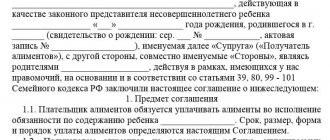What does payment of a company's debt by a third party mean? This means that the company's debt is repaid by another company. As a rule, she herself is a debtor of the enterprise, and therefore the funds paid to her go towards repaying her debt.
In what cases is it relevant to pay a debt by a third party? Almost every company that has been operating for some time is both a creditor and a debtor. That is, it both lends funds and gives them to third-party companies. All this makes it possible to pay off your debt to one organization with the funds of another. This will be relevant if the company currently does not have the required amount of funds. This can be a convenient way for a third party paying off someone else's loans to pay off their debt.
How to account for payment for goods (work, services) by a third party ?
Main features of the operation
The Civil Code of the Russian Federation does not say anything about the procedure for processing debt payment by a third party. The algorithm used was formed by practice. It consists of the following stages:
- The company sends a letter to its debtor with a request to pay his debt.
- The debtor transfers his funds to the main creditor. The order specifies the appropriate purpose of the payments - payment for the debtor.
How or for a third party under the simplified tax system
A letter of request and an order with an appropriate note are all confirmation that the company has paid the debt for another organization. The presence of these documents is important, since without them, the company that paid off the debt can begin to collect the paid funds from the recipient. The basis is the enrichment of the creditor resulting from an erroneous payment. Without supporting documents, both the main debtor and his creditor bear the risks. If the company begins to collect funds, the debtor will have to pay the debt to the creditor himself.
How to reduce the risk of collecting client tax debts from the bank as a third party?
IMPORTANT! An entrepreneur cannot control what a third party indicates in his payment order.
Therefore, it is doubly important to draw up a letter of request and take confirmation of its receipt. The paper will serve as proof of the operation. Proper documentation is a way to reduce all possible risks.
Legal regulation
In Art. 313 of the Civil Code provides for the right of any company or person to pay a fee for a third party. This is legal if, according to other legislative acts, the debtor is not obliged to make the payment himself. For example, such terms are sometimes included in formal agreements drawn up between counterparties.
Attention! Practice shows that there are no obstacles to another company making payments.
If the transaction is completed correctly, the payer does not face unpleasant consequences represented by the interests of tax authorities or representatives of other government agencies. For this purpose, letters and other documents are drawn up.
Rules for writing a letter of request for debt repayment
The request letter must include the following information:
- Name of the legal entity entrusted with covering the debt. This is so important because even if the legal entity does not put the required mark in the payment order, using the details it will be possible to prove the purpose of the payment.
- An obligation that is transferred to a third party. In particular, you need to disclose its details: details of the agreement on the basis of which the debt arose, its amount.
- If the third party is a debtor of the enterprise (as is the case in most cases) and the funds paid by him go towards his debt, it is recommended to also indicate this in the letter. This is beneficial to both the first and second parties. The company has a greater chance that the counterparty will agree to such a transaction. The debtor can be sure that the payment will actually go towards the obligations and the creditor will not oblige him to repay the debt.
- The debtor to whom the letter is sent may not know all the intricacies of drawing up a payment order. It is also advisable to mention them. In particular, specify the need to indicate the purpose of the payment - repayment of the debt of another company.
ATTENTION! The letter of request must be signed by the head of the enterprise or a person with appropriate authority. The presence of a signature is of interest to the debtor, since it proves that the order actually took place.
IMPORTANT! The payment is made by a third party, and therefore the company does not have direct access to documents confirming the payments made. However, their presence is necessary to prove repayment of the entire amount of debt. Therefore, it makes sense to request a copy of the payment order from the debtor. The paper must be marked with execution from the financial institution.
Example of a letter of repayment of obligations
General Director of Prodvizhenie LLC I.P. Ufimtsev Chelyabinsk, st. Kirova 1, no. 1 From the General Director of Oliva LLC V.V. Ripak Chelyabinsk, st. Vorovskogo, 6
Ref. dated June 20, 2021 No. 363
LETTER about transferring money towards debt
We have a debt to Oliva LLC in the amount of 200,000 rubles. We ask you to pay off the debt of Oliva LLC in the amount of 200,000 rubles. Details for payments: TIN 11133355443 KPP 7657488956 OGRN 10754754785 r/s 407657776544878558654 in the Chelyabinsk branch of the Sberbank of Russia K/s 6655999996665555700088 BIK 066468888886
Transfer of payment using these details will mean the termination of the debt of Prodvizhenie LLC to Oliva LLC in the amount of 200,000 rubles.
In the instruction, we ask you to mention the purpose of the funds: “Payment for the rental of premises for Oliva LLC under agreement No. 10 dated July 10, 2021 in the amount of 200,000 rubles is not subject to VAT.” We also urge you to send us a copy of the payment order. The document must bear a mark from the banking institution regarding execution.
General Director of Oliva LLC Ripak /V.V.Ripak/
In what cases is such an appeal prepared?
In business activities, a situation often arises when one company pays the debt of another organization. In some cases, such a transfer of the obligation to pay funds is impossible, and the debtor is obliged to fulfill it independently - for example, if the agreement between the parties expressly states that his party does not have the right to transfer the obligation to pay the debt to a third party.
If there is no such condition, as well as there are no legislative obstacles to transferring the debt, the company has the right to ask a third party - the actual payer - to transfer the debt for it. In such situations, as a rule, this third party has an unfulfilled obligation to the debtor, and it extinguishes it in this way.
That is, there are actually three sides to this relationship:
- original debtor;
- creditor or recipient of money;
- actual payer.
For example, company A, the debtor, the person who initially bears the obligation to pay, has a debt to company B, the creditor, in the amount of 100,000 rubles. At the same time, company B - the actual payer - has a debt to company A in the amount of 150,000 rubles. Company A sends to company B an application to transfer money to another organization, company B transfers 100,000 rubles to the recipient - and this money is written off from its debt to company A, the remaining debt is 50,000 rubles.
IMPORTANT!
The recipient is obliged to accept such fulfillment of obligations to him - this rule is established by Article 313 of the Civil Code of the Russian Federation.
Accounting
Let's look at the postings used using the example from the above letter of request. Oliva rents premises for 200 thousand rubles excluding VAT. She shipped products to Prodvizhenie LLC in the amount of 200,000 rubles. The cost of the goods was 160,000 rubles. A letter requesting payment of Oliva's debt was sent. The payment has been made. Both parties chose the simplified tax system, and therefore they do not pay VAT. Let's look at the entries in the accounting book of Oliva LLC:
- DT62 KT90-1. Amount: 200,000 rubles. Explanation: total debt of Promotion.
- DT90-2 KT41. Amount: 160,000 rubles. Write-off of the cost of goods transferred to Promotion.
- DT44 KT60. Amount: 200,000 rubles. Reflection of debt to the lessor of Oliva.
- DT60 KT62. Amount: 200,000 rubles. Amortization .
ATTENTION! The last entry is made only after receiving the primary document, that is, a copy of the payment order. The records should mention primary documentation confirming the operations performed.
How to fill out a payment order?
There are several features in filling out a document to pay tax for another legal entity:
- in the payer field you should indicate the name of the organization (or the name of the individual) that makes the payment;
- in the fields “Taxpayer INN” and KPP, the relevant details of the organization for which the tax is paid are indicated;
- in the “Purpose of payment” field, you should first indicate the INN and KPP (if any) of the payer, and then, separated by two slashes (//), the name of the organization for which the payment is made, the name of the tax, period, type of payment and other important data;
- in field “101” the code “01” is entered - this means that the person for whom the payment is being made is a legal entity.
An example of how to fill out a “payment form” to pay taxes for another legal entity is shown in the following image.
In the above example, the individual K.I.V. makes an advance tax payment for U____ LLC in connection with the application of the simplified tax system.
Possible risks
Such almost circular debt repayment is characterized by a considerable number of risks:
- The primary debtor sending the letter will refuse to acknowledge his request and that the debtor has made payment on his debt. The counterparty will have to repay the debt again.
- The counterparty will make the payment, however, after the creditor writes off his debt, he will return the funds on the basis of an erroneous payment. You will have to pay the debt amount again.
- The creditor files a claim with the primary debtor that payments have not been made even though payment was made by a third party.
You can easily protect yourself from all these troubles. This requires proper documentation. Based on the available papers, it is possible to confirm all the details of the transaction that the other party denies. The main documents that will be required: a letter of request with all the details and a payment order.
When firms pay fees for another business
If an organization does not have available funds to fulfill its debt obligations, then it has the right to turn to another company with a request to repay the debt to the creditor. To do this, an official letter is generated containing information about the amount of debt, the creditor and the timing of repayment.
Typically, a transfer for another company is performed in the following situations:
- on the basis of a request from a debtor who, for various reasons, cannot cope with the debt on his own;
- a third party faces the possibility of losing property if the debtor does not repay the debt.
A company that decides to help a counterparty can transfer money to a partner or a direct creditor. Additionally, a letter of payment to a third party is drawn up, which serves as confirmation of the provision of assistance.
Attention! Often directors of companies make such a request to founders, who contribute funds from their personal capital.
Applying for a loan with a guarantor
In order to better understand the issues of payment by third parties, we can consider a particular and most common example of this phenomenon: a loan with a guarantor. It is issued in cases where it is necessary to take out a loan for a fairly large amount, but the amount of the white salary is not enough for approval by the bank. Then loans that are issued under the guarantee of legal entities and individuals can serve as a way out of the situation.
A loan with a guarantee is one of the main mechanisms that allows you to ensure the fulfillment of obligations assigned to the borrower. In this case, the guarantor is a person who can be either an individual or a legal entity, who repays the borrower’s debt if the latter fails to comply with the terms of the loan. Both parties to the agreement (borrower and guarantor) bear equal responsibility.
Clients apply for a loan with a guarantor in the following situations:
- to reduce interest rates;
- to receive a larger amount of money;
- in the absence of official employment (in some cases);
- with a not entirely favorable credit history.
If the borrower violates the terms of the guarantee agreement, responsibility for their implementation falls on the shoulders of the guarantor. He will be required to repay the principal amount of the debt and the accompanying commission, which includes fines, penalties, interest and other payments. As you might guess, the guarantor is a third party when concluding a loan agreement.
When applying for a loan, a surety agreement must be drawn up. Depending on the parties involved in creating the agreement, it can be either bilateral - between the lender and the guarantor, or trilateral, in the creation of which another party - the borrower - participates. If the need arises, a collateral agreement is additionally drawn up. It is drawn up to ensure additional security of the transaction; the property of the borrower or guarantor serves as collateral.
Let's sum it up
So, paying an obligation to a third party is a completely common and safe operation. It does not entail any negative consequences either for the payer or for the one for whom he makes the payment. It does not matter whether the payer and the debtor are in a contractual relationship or not. At the same time, this is very convenient, since it allows you to avoid unnecessary operations, delays in fulfilling obligations and related troubles. In this way, you can pay not only under contracts with counterparties, but also pay taxes.
Paying taxes
When making payments by third parties, the question may arise as to how legal it is to use a VAT deduction. However, neither the Tax Code nor the Ministry of Finance see any obstacles to such actions. This is also evidenced by the absence of special provisions on the use of deductions in Article 172 of the Tax Code when paying taxes by third parties, so this does not affect the use of deductions.
Long-term judicial practice also speaks in favor of companies that deduct VAT after payment is made. Court decisions have confirmed that the actual payment to a third party does not affect the validity of using VAT deductions.
Transactions with the payer when paying off someone else's tax debts
In the previous section, we dealt with the transactions made by the taxpayer when a third party pays off his tax debt. What entries does the payer need to make in such a situation in his accounting?
The posting diagram in the payer's accounting is shown in the figure below:
There is a limitation when paying tax amounts for a debtor - you can only pay off a tax debt for a third party with money. It will not be possible to direct your own tax overpayment for these purposes. Tax legislation does not provide for such a method of repaying tax debts for a third party (letter of the Ministry of Finance of Russia dated June 18, 2018 No. 03-02-07/1/41421).
Is it possible to pay for a third party tax debts that arose before 2021 - the moment from which the law stipulated the possibility of paying taxes and insurance premiums for third parties? Tax authorities do not object and recognize such payments as legitimate.
We discuss here what arguments allow you to pay past tax debts for third parties.
Tax payments for a third party: postings from the debtor
No other payment requires strict adherence to payment deadlines, like the group of tax payments (taxes, fees, insurance premiums). If in most cases it is possible to agree with the counterparty on the postponement of deadlines or to achieve payment in installments, with tax payments the situation is much more complicated. For late tax payments, the taxpayer suffers in all areas:
- Financially - forced to pay penalties and fines for any delay in tax payments (including if there is a delay of 1 day).
- Reputational - thanks to the Transparent Business service, information about unpaid taxes, fees and contributions by the taxpayer is not closed. Interested parties, when assessing a potential partner, if such information is available, may decide the issue of a potential partnership not in his favor.
- In the main business activity - if the company plans to participate in competitions to obtain profitable orders. Among the mandatory criteria for selecting applicants for execution of an order may be the requirement that there are no unpaid taxes and fees.
As a result, the issue of timely payment of tax payments is always acute for most taxpayers. And the possibility of repayment of such amounts by third parties becomes particularly relevant. Moreover, from 2021 such an opportunity is directly provided for in Art. 45 of the Tax Code of the Russian Federation.
The following entries are made in the accounting records of the taxpayer for whom tax payments are being made:
Find out what documents tax authorities recommend drawing up in such cases from these publications:
- “Paying taxes for a third party - why does the Federal Tax Service ask to conclude an agreement?”;
- “The Federal Tax Service has developed rules for issuing payment slips when paying taxes for third parties”.









